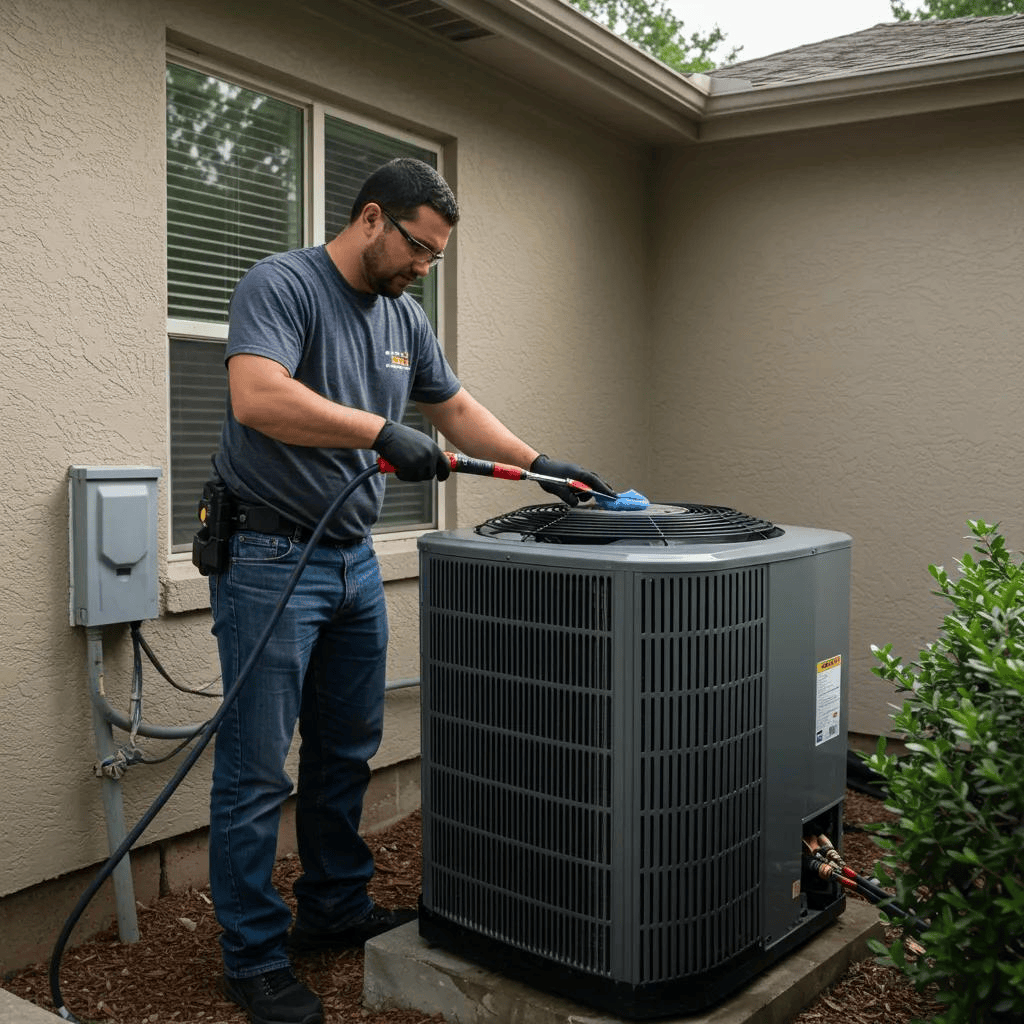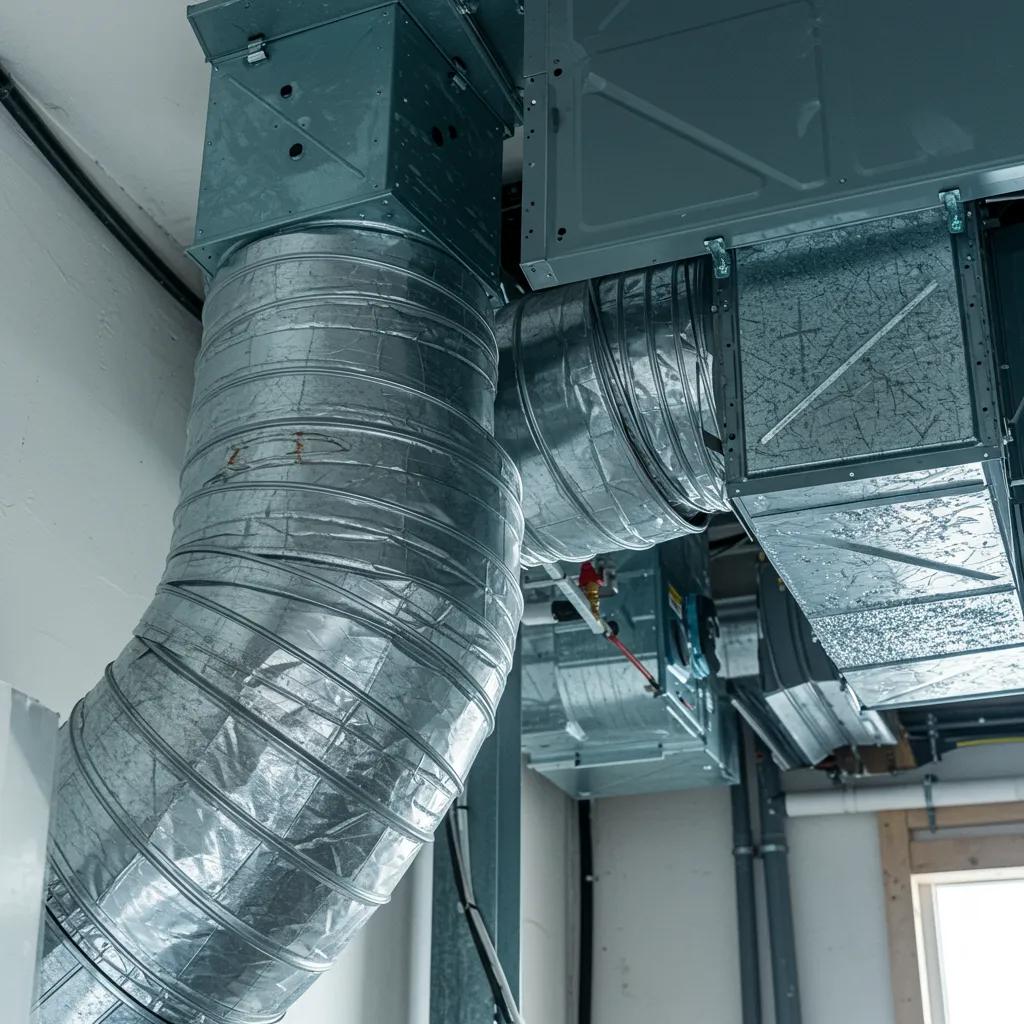

Keeping Your Austin HVAC Running Smoothly: Expert Cleaning for Peak Performance and Health
Giving your HVAC components a professional clean is key to restoring their designed airflow and heat-transfer capabilities. Over time, dust, grime, and even biological growth can build up, clogging vents, coating coils, and hindering your blower. This guide dives into what thorough HVAC component cleaning entails, why it's a game-changer for energy efficiency and indoor air quality, and how specialized services for your furnace, AC, and air ducts can cut down on repair risks and extend your system's life. You'll learn the specifics of cleaning furnace blower motors, evaporator and condenser coils, and keeping your ductwork pristine. We'll also cover how often Austin households and businesses should schedule these services, tackle common doubts about duct cleaning, and provide practical checklists and comparison tables so you know exactly what to expect. Plus, we'll touch on our convenient planned maintenance options, like the Bi-Annual Professional Cleaning & Tune-Up! through our Preferred Club Membership, to keep things running perfectly year-round. Let's get started on why professional HVAC component cleaning is so vital for optimal performance.
Why Professional HVAC Component Cleaning is a Must for Peak Performance
When your HVAC components are professionally cleaned, obstructions are removed, and heat-transfer surfaces are restored. This allows your system to operate much closer to its original design, boosting its capacity and cutting down on energy use. Dirt and gunk act like insulation on your coils and block airflow in your ducts, forcing your compressor to run longer and your fan motor to work overtime. Cleaning reverses these effects, bringing your system back to its intended efficiency. The direct results? Lower energy bills, fewer surprise repair calls, and noticeably better indoor air quality because less particulate matter is being recirculated. Industry standards confirm that targeted cleaning is a smart preventative maintenance practice, complementing regular filter changes and tune-ups. Next, we'll explore exactly how dirt and debris sabotage your system's efficiency.
How Dirt and Debris Sabotage Your HVAC System's Efficiency
Dust and debris piling up on your evaporator and condenser coils act as barriers, making it harder for heat to transfer. This means your system has to run longer, driving up energy use and putting extra wear on components. When your furnace blower motor or fan blades get coated in dust, static pressure increases, airflow suffers, and the whole system becomes inefficient. To compensate, the system might force higher fan speeds or longer cycles to hit your desired temperature. Restricted airflow in your ducts adds even more resistance, reducing the amount of conditioned air reaching your living spaces, leading to uneven comfort and higher energy bills. Understanding these mechanics clearly shows why cleaning your coils, blower motor, and ducts is a smart, cost-effective way to save energy, which naturally leads us to the health benefits.
The Health Perks of Keeping Your HVAC Components Clean

Cleaning your HVAC components helps clear out airborne allergens and potential microbial hotspots that can worsen respiratory issues and degrade your indoor air quality. By removing settled dust, pet dander, pollen, and early signs of mold from your ducts and coils, you significantly reduce the amount of contaminants circulating through your ventilation system. This reduction in airborne irritants can lessen allergy triggers and decrease occupant exposure to harmful particles, leading to measurable improvements in your home's air quality, especially when paired with better filtration. The next section will show how these health and performance gains also contribute to a longer system lifespan and fewer repairs.
How HVAC Cleaning Extends System Life and Cuts Down on Repairs
By restoring proper airflow and thermal exchange, cleaning reduces the strain on your compressors, blowers, and heat exchangers. This means fewer breakdowns and less frequent repairs. Clean coils require less effort from your system to meet cooling demands, and a dust-free blower motor runs cooler, reducing wear on its bearings. Proactively clearing debris from flues, burners, or condensate lines also prevents issues like ignition problems, corrosion, and blockages that can lead to costly downtime. These long-term benefits make scheduled component cleaning a highly valuable maintenance activity, naturally leading us to a closer look at what an expert cleaning process involves.
What Airsheen’s Expert HVAC Component Cleaning Process Includes
At Airsheen Services LLC, our professional cleaning process is a structured, inspection-driven approach: diagnose, clean, sanitize, and test. We focus on your furnace, AC coils, blower motor, and ductwork. Our technicians begin with a thorough inspection to pinpoint airflow restrictions, coil fouling, and sources of contamination. Then, we use coil-safe cleaners and specialized tools to remove deposits without harming delicate fins or coil geometry, followed by high-powered vacuums. We apply sanitization and targeted microbial treatments where needed, and finally, we test the system to confirm restored airflow, pressures, and temperature differentials. This methodical sequence not only slashes energy waste and boosts indoor air quality but also provides valuable documentation for future maintenance planning.
Before we show you our EAV comparison that breaks down what each cleaning scope delivers, here’s a quick rundown of the typical cleaning stages to set your expectations.
- Inspection and Diagnostics: We thoroughly assess your system to identify fouling, airflow problems, and any safety concerns.
- Targeted Cleaning: We meticulously clean coils, brush blower motors, and vacuum ducts using the right tools for the job.
- Sanitization and Remediation: We apply antimicrobial treatments or sanitizing agents when necessary.
- Testing and Verification: We measure airflow, temperature differences, and overall system operation after cleaning.
This step-by-step process ensures clear, predictable results and leads into a comparison table detailing the outcomes you can expect from each service type.
The following table compares our core component services, outlines the key steps involved, and highlights the typical results our customers experience.
This EAV-style comparison clearly illustrates how each service targets specific issues and prepares your system for reliable operation. Now, let's dive into the specific steps for furnace cleaning and how they boost heating efficiency.
Key Steps in Furnace Cleaning for Better Heating Efficiency

Furnace cleaning starts with a safety-focused check of the heat exchanger and combustion parts. Then, we precisely clean the burner assembly and clear out any dust buildup in the blower compartment. Our technicians also clean or verify the proper function of flame sensors and ignitors, removing any debris that could hinder combustion airflow or cause overheating. After cleaning, we balance the airflow to restore designed rates, which improves heat transfer and reduces how often the system cycles on and off. These steps minimize the risk of component stress and help keep your heating safe and efficient all season long.
How AC Coil Cleaning Boosts Your Air Conditioner's Performance
Cleaning your AC coils restores the surfaces responsible for heat exchange, allowing your refrigeration cycle to work efficiently again. This directly cuts down on compressor workload and enhances cooling capacity. A dirty evaporator coil struggles to remove moisture, leading to higher indoor humidity and longer run times. Similarly, a fouled condenser coil can't reject heat effectively outdoors, causing discharge temperatures to rise. Cleaning both types of coils lowers system pressure and energy use, potentially improving efficiency by noticeable percentages, especially when combined with the right refrigerant charge and airflow. Our next section will detail the differences between coil types and the measurable performance impacts.
What Thorough Air Duct Cleaning Involves for Better Indoor Air Quality
Thorough air duct cleaning uses specialized agitation tools, brush systems, and negative-pressure vacuuming to dislodge and remove settled dust, pollen, and even minor biological growth from inside your ducts. We access the system as needed to reach all trunk lines and branch runs, paying close attention to sealing any torn flex joints or gaps that could let contaminants back in. When combined with upgraded filters, duct cleaning significantly reduces the amount of recirculated particles, allowing your HVAC filtration to do a more effective job of maintaining healthy indoor air. The next subsection explains how our bi-annual professional HVAC services supports long-term HVAC health and maintenance scheduling.
How Bi-Annual Professional Cleaning Keeps Your HVAC Healthy Long-Term
Our bi-annual professional cleaning service is designed to handle seasonal changes in your HVAC system's workload. By scheduling service twice a year, we get two opportunities to inspect, remove any emerging buildup, and fine-tune your system's operation before the peak summer and winter seasons hit. This regular twice-yearly service prevents the gradual accumulation of contaminants that can slowly decrease efficiency, often without you noticing. Scheduling services seasonally also aligns perfectly with filter changes and refrigerant checks, creating a cohesive preventative maintenance routine that extends your equipment's life. This consistent approach leads us to recommendations on how often homeowners and businesses in Austin should schedule their HVAC component cleaning.
How AC Coil Cleaning Boosts Your Air Conditioner's Performance
Cleaning your AC coils restores the thermal conductivity of your evaporator and condenser surfaces, allowing the refrigeration cycle to move heat efficiently. This reduces the compressor's workload and improves overall cooling capacity. A dirty evaporator coil hinders the removal of latent heat, leading to increased indoor humidity and longer run times. Meanwhile, a fouled condenser coil struggles to reject heat outdoors, raising discharge temperatures. Cleaning both coil types lowers system head pressure and energy consumption, potentially improving efficiency by measurable percentages, especially when paired with a correct refrigerant charge and balanced airflow.
Differences Between Evaporator and Condenser Coil Cleaning
Evaporator coil cleaning focuses on the indoor-accessible surfaces, managing condensate drainage and microbial growth using gentle, coil-safe cleaners and careful rinsing to prevent water issues inside your home. Condenser coil cleaning addresses debris exposed to the outdoors, using low-pressure rinsing and fin-safe agitation to avoid damaging the fins while maximizing airflow for heat rejection. Each cleaning process requires different access techniques and equipment due to location and exposure, but both aim to restore surface heat exchange and are essential for full-system performance restoration. The following subsection will quantify how coil cleaning reduces energy use and costs.
How Coil Cleaning Reduces Energy Consumption and Costs
Restoring clean coil surfaces means your compressor and fan don't have to run as long. Published industry estimates and field studies suggest efficiency improvements that often translate to single-digit to low-double-digit percentage reductions in energy use, depending on how dirty the coils were initially. For instance, severely fouled coils can significantly reduce system capacity and substantially increase energy use, while moderate fouling corrected by cleaning typically yields measurable savings over subsequent cooling seasons. When coil cleaning is combined with the correct refrigerant charge and proper airflow, the total impact on energy consumption is greater than any single action alone. Understanding these quantified benefits helps owners prioritize coil cleaning as part of their maintenance planning.
Airsheen’s Process for Professional AC Coil Cleaning in Austin
At Airsheen Services LLC, we perform coil cleaning by first inspecting access panels and drainage systems. Then, we apply coil-safe detergents and use controlled rinsing, taking care to protect nearby electrical components and indoor finishes. Our technicians verify condensate drainage and flush pans to prevent standing water and microbial growth, documenting before-and-after conditions to confirm restored heat transfer. After cleaning, performance testing confirms improvements in temperature split and airflow, informing any additional recommendations such as filter upgrades or duct balancing. This process aligns with best practice cleaning methods and supports predictable summer performance.
Frequently Asked Questions
1. What are the signs that my HVAC system needs cleaning?
You might notice signs like reduced airflow from vents, uneven heating or cooling across rooms, longer system run cycles, and visible dust or debris when your system starts up. If you hear unusual noises from the blower motor or see an increase in energy bills without changes in usage, these could indicate your system is struggling due to accumulated dirt and debris. Regular inspections can help catch these issues early, ensuring timely maintenance and optimal performance.
2. How can I tell if my air ducts are dirty?
Dirty air ducts often show up as visible dust buildup around vents, a musty odor, or an increase in allergy symptoms among occupants. If you notice a significant amount of dust settling on furniture shortly after cleaning, it might mean your ducts are circulating dust and allergens. Also, if your HVAC system is running longer than usual or having trouble maintaining set temperatures, it could be due to airflow restrictions from dirty ducts. Regular inspections can help confirm the condition of your ductwork.
3. Are there any DIY methods for maintaining HVAC cleanliness?
While professional cleaning is essential, homeowners can take several DIY steps to help maintain HVAC cleanliness. Regularly replacing your air filters is crucial, as it prevents dust and allergens from entering the system. Additionally, vacuuming around vents and ensuring outdoor units are clear of debris can help maintain airflow. Monitoring indoor humidity levels can also reduce dust buildup and mold growth. However, for a truly thorough cleaning, especially of ducts and coils, professional services are recommended to ensure comprehensive maintenance.
4. How does HVAC cleaning impact energy bills?
Regular HVAC cleaning can significantly lower your energy bills by improving system efficiency. When components like coils and ducts are clean, the system operates more effectively, requiring less energy to maintain your desired temperatures. Dirty coils and blocked ducts force the system to work harder, leading to increased energy consumption. Studies have shown that proper maintenance, including cleaning, can result in energy savings of up to 30%. Therefore, investing in regular cleaning can lead to long-term cost savings on your energy bills.
Conclusion
Regular professional cleaning of your HVAC components significantly boosts system efficiency and improves indoor air quality, leading to lower energy costs and fewer repairs. By understanding the importance of targeted maintenance, homeowners and businesses can ensure their HVAC systems operate at peak performance. To experience these benefits firsthand, consider scheduling a cleaning service with Airsheen Services LLC today. Invest in your comfort and health by prioritizing HVAC maintenance for a cleaner, more efficient environment.
Recent Posts
Customer Testimonials




